Journal of APPLIED BIOMEDICINE
ISSN 1214-0287 (on-line)
ISSN 1214-021X (printed)
Volume 9 (2011), No 2, p 63-102
DOI 10.2478/v10136-009-0023-7
Congruent biospheric and solar-terrestrial cycles
Germaine Cornelissen, Patricia Grambsch, Robert Bruce Sothern, George Katinas, Kuniaki Otsuka, Franz Halberg
Address: Germaine Cornelissen, Halberg Chronobiology Center, University of Minnesota - MMC 8609, 420 Delaware Street SE, Minneapolis, MN 5545, USA
corne001@umn.edu
Received 6th March 2010.
Revised 29th June 2010.
Published online 27th July 2010.
Full text article (pdf)
Abstract in xml format
Summary
Key words
Introduction
Materials and Methods
Results
Discussion
Conclusion
Acknowledgement
References
SUMMARY
Selective congruence, namely a pairing of various biospheric cycles of certain frequencies with different environmental ones and further
selectivity of phase behavior at the given frequency characterize an ultradian to infradian, prominently circadian transdisciplinary spectrum.
Diseases documented among others to be influenced by the cosmos range from individuals' strokes to populations' crime and terrorism, conditions
studied by chronomics as time structures (chronomes). Methods of investigation include the extended cosinor allowing for the added estimation of
the period with a measure of uncertainty, as well as global and gliding spectral windows complemented by chronobiologic serial sections. These
methods estimate, each of them with uncertainties, changes as a function of time in weather on earth and in space on the one hand and in human
personal and broader affairs on the other. They further map features of these time structures that may change as a function of time in a logically
consistent way. Associations of several biological time series with physical environmental variables are presented herein, as are methods used for
their investigation and a statistical assessment of their congruence.
KEY WORDS
biosphere; chronome; congruence; cosmos; transdisciplinary approach
INTRODUCTION
The brain's action potentials are faster than those of
the heart. The gut's movements, certainly its refilling
and evacuation, are much slower. Reproduction is
slower yet. Living matter functions concomitantly on
vastly different frequencies, as a system open to its
environment. Hence a host of cycles external to the
organism influences it, sharing its frequencies but not
necessarily its phases. This is best documented for a
circadian system, which when synchronized in period
(which happens to coincide with the earth's rotation
around its axis) can show differences in phase
representing a division of labor in time. Likewise,
about 5-month cycles in 15 years of mostly daily data
on the volume of urine of a healthy man and on his
steroidal metabolites can share their period with both
relative sunspot numbers (Wolf or Zurich numbers,
International Sunspot Count, or Brussels SIDC Index)
and geomagnetism, but can follow different phases,
steroids traveling with a planetary geomagnetic index
and urine volume, perhaps, locking in transiently with
sunspots.
There are solar-interplanetary-terrestrial
associations with human health versus disease, long
claimed and descriptively documented by leaders of
genius in the field of in the past, such as Chizhevsky
(1921), and at present by Mikulecky (2007) and Ertel
(1996). They recognized that health includes
economic, political and climatic well-being and that
all aspects of the biosphere depend on weather on
earth and in space.
Time structures of environmental and biological
variables can be resolved as consisting of chaos,
trends and/or cycles. Resolution of the latter depends
on the sampling density and on the length of time
series. When cycles around and in us are being
compared in spectra, the non-stationarity of
components must be assessed. Some of these cycles
were described as quasi-periodic or quasi-persistent
because of their variability that can include transient
failures to detect them. We separate these cycles into
photics, related to electromagnetic radiation in the
visible domain, and non-photics, including particle
radiation from the sun and the associated helio-,
interplanetary, ionospheric- and geo-magnetics, UV
flux, gravity and everything else invisible that is
meaningfully measurable in the cosmos. We focus on
infradian cycles with periods longer than 28 hours.
(Circadian aspects - periods between 20 and 28
hours - that also include "non-photic" space
weather-related as well as feeding schedules, and
ultradians, periods shorter than 20 hours, that also
have counterparts in geomagnetics, are not considered
herein.)
We introduced the term "aeolian" not only to
describe the non-stationarities but also to specify the
steps required for their study with their existing
limitations. A first inferential statistical procedure
involves global (entire time series-based) tests of the
"no-cycle" (zero-amplitude) assumption and thus of
the probability that each anticipated spectral peak is
the result of chance variation. If rejected, the
alternative hypothesis that it represents a cycle is
accepted. The rejection of the zero-amplitude
assumption leads to parameter estimation, including
the derivation of CIs (95% confidence intervals) for
each parameter of the fitted model. In particular, CIs
of the periods are useful to assess the extent of
similarity of cycles characterizing different variables.
So are the CIs of the amplitudes that indicate the
prominence of a given component by the distance
from zero of the lower limit of its CI. Congruence is
defined by the total or partial overlap of CIs of
periods of anticipated cycles between two (or more)
variables. An overall assessment of congruence over
a specific spectral region can also be defined by the
proportion (out of the total) of statistically significant
spectral peaks with overlapping and/or overlying CIs
of their periods. The proportion of similarities is
likewise defined by proximal (yet not overlapping)
CIs of periods, when the distance between CIs is less
than the shortest CI/2 of the periods involved. These
admittedly arbitrary definitions need to be improved
as data accumulate and distributions of congruence
become available for study by "subtraction and
addition" ("remove and replace") approaches. We
herein focus on solar wind speed (SWS) and the
antipodal geomagnetic index aa, neither the sole nor
the most pertinent indices of heliogeomagnetics. The
relative merits of different gauges of solar-
terrestrial-biospheric associations remain to be
systematically compared.
Cycles constitute life at all levels of integration,
including the atomic level, where they are considered
for the case of the origin of about-weekly rhythms
(Ulmer et al. 1995). An about 21-hour cycle, among
others, characterizes a prokaryote (Halberg and
Conner 1961) and about 1-, 3.5- and 7-day cycles,
eukaryote single cells (Broda et al. 1986, Cornelissen
et al. 1986, Schweiger et al. 1986) and organs such as
the human gut (Cornelissen et al. 2002, Hoogerwerf
et al. 2007). Somewhat specific and yet many other
periods are validated for the heart (Sothern et al.
2009b), the brain (Halberg et al. 2003a) and the
health of individuals' body and mind as a whole and
for various affairs of populations (Halberg et al.
2008c). Biospheric cycles at their diverse
organizational units and frequencies, the topic of
chronobiology, resonate with a broad spectrum of
terrestrial and extraterrestrial counterparts (Halberg et
al. 2000, 2008c), the topic of chronomics (Halberg et
al. 2001). Cycles from the environment, near and far,
are reciprocal to those in living matter, in the sense of
having a roughly corresponding period. In the first
place, the cosmos generated the cycles that constitute
life. The biosphere slowly returns the favor, adding its
societal schedules, often fashioned close to the natural
cycles. Transdisciplinary reciprocal periodicity,
photic and non-photic, postulated and documented in
1991 (Halberg et al. 1991, 2000, 2001, 2008c) in
inferential statistical terms (Halberg 1980,
Cornelissen and Halberg 2005, Refinetti et al. 2007),
with deterministic chaos and trends, constitute time
structures, i.e., chronomes of cosmic effects in the
biosphere (Halberg et al. 2001). While the problem
has been discussed with great enthusiasm by
innumerable others, with notable exceptions, concern
about uncertainties associated with the many cycles
reported was conspicuous by its absence (Dewey and
Mandino 1971). This was a great disservice to the
field and perhaps the root cause for its neglect.
Nonetheless, without an inferential statistical
approach, the vast literature on solar- terrestrial-
biospheric associations had been scholarly reviewed
and summarized in Fig. 1 (shaded part).
Much-written-about cosmic-biospheric interaction
is too often descriptively statistical (Dewey and
Mandino 1971), based on the inspection of data
plotted along scales of time or frequency, interpreted
by the unaided eyes, more often than not without
estimates of uncertainties. The prefix "quasi" before
"periodic" and before "persistent" is a recognition of
non-stationarity (Bartels 1959), sufficing neither as an
excuse for ignoring tests of a cycle's validity nor for
failing to look at uncertainties of its parameters, as a
sine qua non for ascertaining the phenomenon's
transdisciplinary associations as putative mechanisms
involved in important human affairs. Until the
ever-present uncertainties as to the reciprocity of
periods being considered are determined, subjective
inferences as to the correspondence of certain periods
are unavoidable. Justified, eloquent inspiration and
enthusiasm (Dewey and Mandino 1971) do not
dispense with needed probabilistic qualification,
recognized by Bartels (1959), and quantification with
uncertainties. CIs of the periods often lack even in the
most outstanding recent publications by physicists
that provide usually only point estimates of the
periods, with few exceptions (Yamamoto et al. 2004,
Takumi et al. 2006). This status quo, also in biology,
has brought the field of solar-terrestrial-biospheric
associations into neglect, even disrepute. Much
time-macroscopic investigation in the molecular
biology of circadian rhythms is published only as
time plots of mean values or displays in frequency,
that provide neither an opportunity to test the validity
of the cycle nor an evaluation of its definition gauged
by the CIs of its parameters. Reanalyses and/or
meta-analyses of the plotted mean values may not
uncover the validity of certain putatively periodic
changes until the original data are alsoconsidered
(Sothern et al. 2009a).
MATERIALS AND METHODS
Our approach presumes that any cycles around us,
like any cycles in us, have been assessed objectively
and quantitatively by generally applicable criteria,
even when the computed uncertainties of their
characteristics serve only for ordering purposes, as is
the case herein. For a test of equality or similarity of
periods, their conservative CIs are computed with a
method proposed and programmed by the late
Marquardt (1963). When Marquardt's conservative
CIs are replaced by his one-parameter CIs, this is
noted.
While CIs are currently conspicuous by their
absence in many contributions of spectra in physics,
Marquardt's method is available and provides
uncertainties concomitantly for each period as well as
for corresponding amplitudes and acrophases
(indicating the overall timing of high values occurring
in each cycle), and for the MESOR (midline-
estimating statistic of rhythm), usually more accurate
and more precise than the arithmetic mean.
Nonetheless, the results from the application of
Marquardt's method to non-stationary cycles have to
be qualified. What Marquardt (rightly for stationary
time series) designated as conservative CIs may be
too liberal when the underlying assumptions are not
met, and consequently the same qualification applies
to cycle detection by the zero-amplitude test. Hence,
as noted above, in the case of non-stationarity, we
refer only to ordering statistical significance yielded
by his procedure. A further qualification stems from
CIs that differ as a function of whether a given cycle
is assessed alone or as part of a composite model.
We use Marquardt's approach, i.a., in studies of
congruence with these limitations in mind: it allows
us to account for noise which we could not do, were
we to define congruence as the proportion of equal
orderingly statistically significant cycles. It is
tempting to do this, since some of the point estimates
of periods in series being compared can be identical
to the second decimal, but these are the exceptions rather than the rule. The alternative is to account for
uncertainties estimated as CIs, and to include in the
definition of congruence a partial overlay of CIs,
Fig. 2. Quite apart from uncertainties assessed by CIs
of periods that relate primarily to the record's length,
there can also be a fair amount of variability in a
cycle's characteristics over time related to its
non-stationarity, as revealed in gliding spectra and
chronobiologic serial sections (Halberg et al. 2008c).

Fig. 1. Overview of solar-terrestrial-biospheric associations compiled from extensive published works.
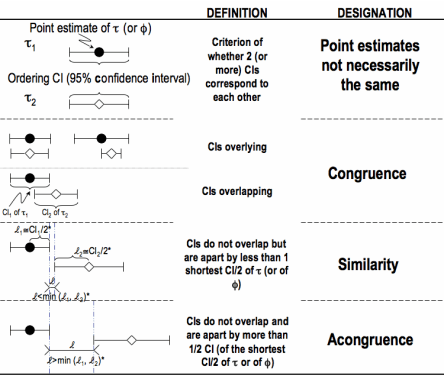
Fig. 2. Two or more variables (or time series) are said to be congruent at a given (anticipated) frequency when the CIs of their periods
assessed nonlinearly (with Marquardt's algorithm) are overlapping or overlying. The concept of congruence can be extended to the broader time
structure with respect to a specified frequency range by considering the proportion of statistical
components in two or more time series of corresponding length with congruent periods. Similarity is defined when the respective
CIs are close but non-overlapping, by contrast to acongruence when the CIs of periods are far apart from each other.
The SWS data, determined in satellites, were
downloaded from http://omniweb.gsfc.nasa.gov and
the aa values from: http://www.geomag.bgs.ac.uk.aaindex.html, serving as a gauge of terrestrial magnetism. The
biological data analyzed herein are self-measurements
(about 5 per day) from a clinically healthy man (RBS)
recorded daily for about 4 decades, while aging from
his twenties to about 60 years of age. Variables
monitored include oral temperature, heart rate (HR),
systolic (S) and diastolic (D) blood pressure (BP),
ratings of mood and vigor, and the estimation of 1
minute (1MTE) by counting (Halberg et al. 1972), the
latter variable recorded for about 35 years (Halberg et
al. 2000, 2008d). Morning BP and body weight
measurements by another man (WRB) treated for
high BP, started at about 52 years of age for the
ensuing 30 years serve for added methodological
considerations, as do BP and HR data collected
around the clock at 30-minute intervals by two other
elderly men treated for MESOR-hypertension (FH
and GSK). So do 7-day BP and HR records (with
measurements every 30 minutes during waking and
60 minutes by night) from 232 residents of Urausu,
Japan, 24-79 years of age (mean ± SD: 56.8 ± 11.2
years).
The data were analyzed by the extended cosinor
(Halberg 1980, Cornelissen and Halberg 2005,
Refinetti et al. 2007). Results from the latter study
were compared by Student t-test between men and
women and age trends were assessed by linear
regression. Participants were also asked to answer a
self-administered questionnaire inquiring about
15 items of a depression scale (geriatric depression
screening scale, GDS). Subjects with a score of 5 or
more on this scale were considered to have a
depressed mood. The circadian period and amplitude
of SBP, DBP and HR were linearly regressed with the
GDS score and compared by Student t-test between
subjects with and without a depressed mood. Testing
was at the significance level 2alpha=0.05.
RESULTS
Wobbliness of environmental and biological variables
Components in SWS and in the aa index can be
extremely wobbly, as seen in Fig. 3A (left, gliding
spectra suffice to reveal). By contrast, periods such
as 0.72 [0.71, 0.73] and 1.06 [1.05, 1.07] year(s) (in
global spectra, right) are seemingly identical for SWS
(top) and aa (bottom). In these particular cases, when
the sampling rate and record length are the same
(except for some missing data for SWS, but not aa),
not only the period estimates but also their CIs
happen to be identical to the second decimal.
Gliding spectra (Fig. 3A, left) suffice to reveal
drastic differences in the time structure of SWS and
aa. The time structure of both variables further differs
from that of a human mental function, RBS' 1MTE,
Fig. 3B (bottom). Some similarities with SWS and aa
are seen nonetheless, notably a band around an about
1.3-year period from 1985 to 1995. All three variables
are characterized by the lack of a consistent, precise
1-year component, Fig. 3B. Numerical results
regarding the periods in global spectra are given in
Tables 1 and 2. RBS's circulation (Fig. 3C), with
focus on his SBP (Fig. 3D) is characterized by a
seemingly dominant calendar year, even though the
lower limit of this period does not cover the precise
year. With some of the non-stationary variability
visualized in the gliding spectra of Figs 3A-D, it
seems clear that alternative objective methods are
needed to complement the CI from a global analysis
(of the series as a whole).
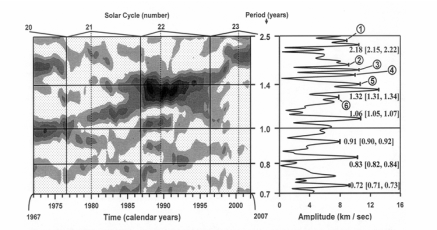
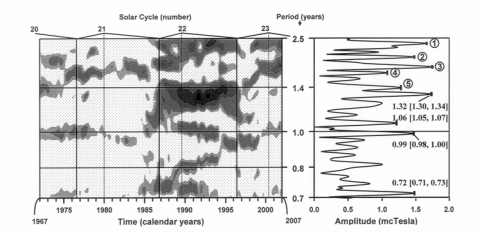
Fig. 3A. A few identical-seeming periods in solar wind speed (top) and geomagnetism (bottom) in global summaries (right) are
qualified by their differences in their time course, seen in gliding spectral windows (left).
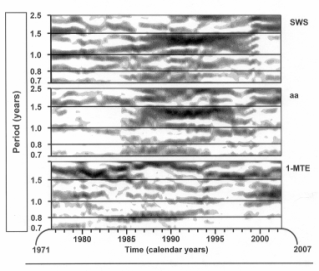
Fig. 3B. Aeolian time course of a human mental function (bottom) aligned with solar wind speed (top) and geomagnetism
(middle) reveals a thinner band around a period of 1.3 years (ordinate) after 1986, corresponding to the thick black bands in
helio-geomagnetics (top and middle).
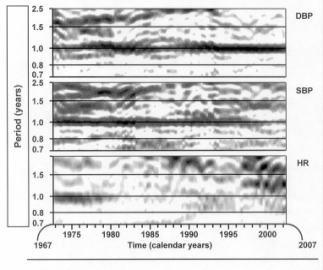
Fig. 3C. Aeolian time course of diastolic blood pressure (DBP; top), systolic blood pressure (SBP; middle) and heart rate (HR; bottom) of a
clinically healthy man (RBS) monitored over 4 decades. Note components with waxing and waning darkness
(amplitude, A) and drifting or even disappearing period (white) resembling or perhaps rather corresponding in kind to the images
of helio- and geomagnetic patterns in Fig. 3B.
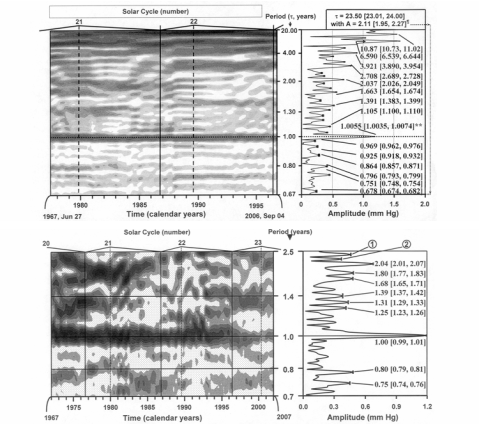
Fig. 3D. Dominance of about 1-year synchronized component in RBS's SBP, yet with coexisting far-transyear component, with a period of
about 1.3 years. In another model, the exact numerical estimate of the period deviated from a precise calendar
year in the third and fourth decimal place as 1.0055, with a CI extending from 1.0035 to 1.0074, prompting Fig. 3E.
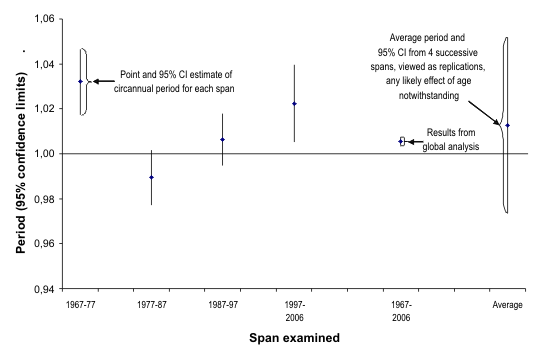
Fig. 3E. Different uncertainties for one of the estimates of a time series, computed, on the one hand, globally by the
conservative method of Marquardt (1963) or, on the other hand, by the summary of estimates derived from the analysis of 4
sections of the same time series for the SBP of RBS. The impression from the global analysis (horizontal arrow) of a
desynchronized yearly rhythm is not supported by the summary of two of the decadal sections whose CIs of the period overlap
the precise year, as does the CI of the average (oblique arrow).

Fig. 3F. Several near-transyears and far-transyears, and cis- (on this side of, i.e., shorter than) years and trans-half-years in RBS's
1MTE are very wobbly, with drifting frequencies in us, as seen in Figs 3B-3D, and around us, Fig. 3A.
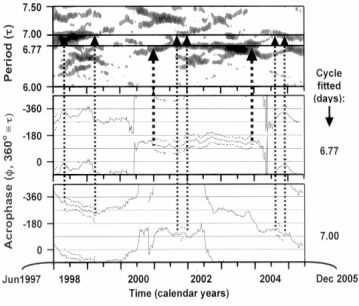
Fig. 4A. Behavior of two selected components of SWS with trial periods of 7.00 and 6.77 days in a gliding spectral window (top), plotting
the percentage rhythm (proportion of variance accounted for by fitted cosine curve of given frequency in specified
interval) as it changes with time in the circaseptan spectral window investigated. The darker the shading, the more prominent
is the signal. Acrophase windows of two chronomic serial sections (middle and bottom) focus on the 6.77-day and 7.0-day
components. The former is statistically significant for only part of the record by a horizontal time course of the acrophases
(bracketed by dots). The precise 7-day cosine fit has only a few dots bracketing a horizontal time course of acrophases, whereas
an initial section with dots shows a gradual advance. These results in the bottom two rows detect the anticipated 6.77-day but
no precise consistent weekly component in helio-geomagnetics.

Fig. 4B. Transdisciplinary selective congruence in the 7-day spectral region in GSK's data, assessed in relation to Dst (Equatorial
geomagnetic index), Ap (averaged planetary A index based on data from a set of specific Kp stations) and Kp
(Planetary geomagnetic index).

Fig. 4C. Time course of components with different frequencies resolved in terrestrially telescopically assessed solar magnetism by analyses
with three complementary interval lengths, revealing that various components seen with a long interval of 21 years (top) undergo changes in a
broad frequency band as a function of time, seen with shorter intervals of 10 (middle) or 5 (bottom)
years.
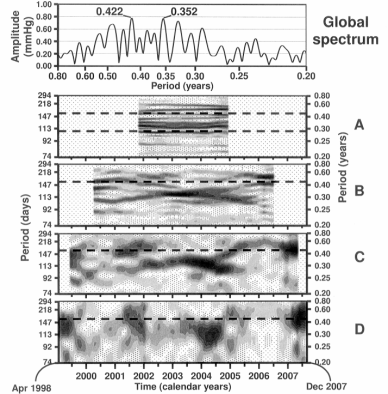
Fig. 4D. Global spectral window (top) with focus on the cis-half-year range of diastolic blood pressure of GSK resolved with four different
interval lengths, revealing a greater variability in time, the shorter the interval length.
One alternate method is to compute the average
variabilities encountered in sections of the series,
Fig. 3E. As compared to the tight CIs from global
analyses (horizontal arrows), uncertainties are much
wider when results from different sections of a time
series are averaged (oblique arrow). The decision as
to how many sections are to be made of any available
time series is subjective, yet use of the sections-based
approach qualifies the global estimate and prevents
premature extrapolation as to whether the circannual
rhythm in SBP is desynchronized or synchronized by
the calendar year. The circannual component in
RBS's SBP is seen overall to be synchronized with
the calendar year by the sections-based method,
Fig. 3E.
A near-transyear (1.00 year < [ tau - CI] < [tau + CI]
< 1.20 years, where is the period estimate) of
1.07-year length for 1MTE differs from precisely
1 year, and the CI of its global period [1.06, 1.08
years] overlaps the CIs of periods [1.05, 1.07 years]
in SWS and aa (see Fig. 3A and 3F). This
transdisciplinary mutual validation of a human mental
function's congruence with very similar periods in
SWS and aa (Fig. 3A), or vice versa, could be
happenstance, yet it warrants further investigation.
When, numerically, congruence at more frequencies
are found between a human mental function and SWS
than between SWS and aa, Table 1, the result gains in
interest. In any event, a remove-and-replace approach
deserves implementation. These associations by
congruence relate to important aspects of personal
and societal health.
Aeolians
Many non-photic infradian spectral components in the
environmental and biospheric aspects of a
transdisciplinary spectrum reveal non-stationarity to
the point of intermittency, as illustrated in Figs 3A-D.
In keeping with an international interdisciplinary
consensus (Chibisov 2005), these irregular,
sometimes intermittent cycles, waxing and waning in
amplitude, drifting, bifurcating, disappearing and
rejoining in frequency, with or without changes in
waveform, quantified by harmonics of fundamental
periods, are dubbed aeolian, after Aeolus, the
capricious ruler of the winds, rather than
quasi-periodic, if and only if their behavior described
in the foregoing is brought into view by analyses
done concomitantly, globally, in spectral windows of
the series as a whole, and temporally, e.g., in gliding
spectra and/or in chronomic serial sections, the latter
displaying parameters like the period, amplitude,
acrophase and MESOR as a function of time, with all
parameters, global or serial-sectional, provided with
their uncertainties.
Fig. 4A combines a gliding spectral window (top)
of SWS with plots, part of serial sections with trial
periods of 6.77 (middle) and 7.0 (bottom) days,
showing that a non-social geomagnetic (Halberg et al.
1991, Roederer 1995, Vladimirskii et al. 1995)
component of 6.77 days is statistically significant for
about half of the record length, as seen by CIs shown
as dots bracketing the horizontal section of 6.77-day
acrophases (middle row). By contrast, the fit of a
7.0-day societal component shows no stable
horizontal time course (Fig. 4A, bottom row). When
it is statistically significant (e.g., initially, while
bracketed by dots), the phases advance, indicating a
period shorter than 7.0 days. Aeolian cycles are thus
seen to drift in period, to the point that they are no
longer detectable with statistical significance, be this
because they are buried in noise or actually disappear
to be re-excited subsequently. These non-
stationarities apply in particular to cycles in particle
radiation from the sun or from elsewhere, broadly to
galactic-, solar-, interplanetary-, ionospheric- and
geo-magnetics, UV flux, gravity and all other
non-photic measurable environmental cycles, briefly
to non-photics. Many factors, beyond our scope
herein, contribute to these non-stationarities that are
in sharp contrast with changes associated with the
visible range of the electromagnetic spectrum, such as
with the day and the seasons that are usually less
irregular.
The term "quasi-periodicity" is here restricted to
describing a lack of inferential statistical
considerations, e.g., a lack of attempt to test the
cycle's validity and/or the failure of seeking estimates
of uncertainties of the parameters of the cycle. This
testing complements the time-macroscopic data
display in gliding spectral windows of Fig. 4A. Fig.
4B provides a chart of about 7-day components
showing differential congruences. Congruences are
selective in that they differ for the BP versus HR of
the same subject (GSK), a man receiving
anti-hypertensive medication. There is congruence of
HR but not BP at a 6.78-day period with both SWS
and three geomagnetic indices, while at other periods,
helio- and/or geomagnetics are congruent only with
BP, Fig. 4B.
In viewing gliding spectra, e.g., of the solar
magnetic field, a good resolution is obtained in the
frequency domain by the use of a long 21-year
interval (Fig. 4C, top). To gain resolution in the time
domain, these results can be complemented by the use
of shorter (e.g., 5-year) intervals (Fig. 4C, bottom).
An intermediate interval of 10 years offers a
perspective in both time and frequency (Fig. 4C,
middle). Whereas a frequency band shows a
component with a period slightly but clearly longer than precisely 1 year with a 21-year interval (top),
this near-transyear appears to be more prominent
toward the middle of the record (middle) and may
even be intermittent (bottom).
A cis-half-year of about 0.42 year is found in the
DBP of a man (GSK), Fig. 4D. With an interval of
6.4 years chosen, a well-defined frequency is readily
apparent (row 2). As the interval for analyses is
shortened, changes as a function of time are readily
seen in the prominence of this component (Fig. 4D,
rows 3-5).
Table 1. Periods of helio-geomagnetics (columns 2 and 3), congruent* with each other or with a mental function (the estimation of 1-minute)
by a healthy man (RBS) over 3.5 decades (column 4) or terrorism (bottom, bold).
| Special
region |
(Period (years) [CI=95% confidence interval] |
|
|
|
|
| | solar wind (SW) |
aa (E) |
1-min time estimation
(1MTE) |
|
SW/
aa |
SW/
1MTE |
aa/
1MTE |
all/
1MTE |
none/
1MTE | | Decade
to
2 years |
15.6 [15.2, 16.0] |
|
|
|
|
|
|
|
| |
10.85 [10.78, 10.92] |
|
|
|
|
|
|
| | 9.54 [9.38, 9.70] |
|
|
|
|
|
|
|
| |
|
8.71 [8.52, 8.90] |
|
|
|
|
|
| |
5.31 [5.38, 5.35] |
|
|
|
|
|
|
| |
|
|
|
|
|
|
|
| | 3.56 [3.52, 3.60] |
|
4.11 [4.06, 4.16] |
|
|
|
|
|
| |
|
2.81 [2.76, 2.84] |
|
|
|
|
|
| |
|
|
|
|
|
|
|
| | 2.17 [2.15, 2.19] |
|
|
|
|
|
|
|
| | 1-MTE congruence with
S (-) and/or E (- - -) |
Para-annual (PA) and parasemiannual (PSA) spectral region (2 y - 3
months) | | - - - |
|
1.92 [1.89, 1.95]* |
1.98 [1.94, 2.01]* |
E |
- |
- |
x |
x |
| |
|
|
1.85 [1.82, 1.88]* |
|
- |
- |
- |
- |
x | | - -, - - - |
1.69 [1.67, 1.72]* |
1.71 [1.69, 1.74]* |
1.71 [1.68, 1.74]* |
SE |
x |
x |
x |
x |
- | |
1.60 [1.58, 1.62]* |
|
|
|
- |
- |
- |
- |
- | | - - |
1.52 [1.50, 1.54]* |
|
1.54 [1.52, 1.56]* |
S |
- |
x |
|
x |
- | |
1.39 [1.37, 1.41]*# |
1.39 [1.37, 1.41]*# |
|
|
x |
- |
- |
- |
- | |
1.32 [1.31, 1.34]*# |
|
|
|
- |
- |
- |
- |
- | | - - |
1.24 [1.23, 1.26]* |
|
1.26 [1.25, 1.27]* |
S |
- |
x |
|
x |
- | |
|
|
1.16 [1.15, 1.18]* |
|
- |
- |
- |
- |
x | | - -, - - - |
1.06 [1.05, 1.07]* |
1.06 [1.04, 1.07] |
1.06 [1.05, 1.07]* |
SE |
x |
x |
x |
x |
- | |
|
|
|
|
|
|
|
|
|
| - - - |
|
0.99 [0.98, 1.01]* |
0.99 [0.98, 1.01]* |
E |
|
|
x |
x |
| |
0.91 [0.90, 0.92]* |
|
|
|
|
|
|
|
- | |
0.83 [0.82, 0.84]* |
|
0.82 [0.81, 0.83]* |
S |
- |
x |
- |
x |
| |
0.72 [0.71, 0.73]* |
0.72 [0.71, 0.73]* |
0.713 [0.708, 0.719] |
SE |
x |
x |
x |
x |
| | - -, - - - |
|
0.599 [0.598,0.600] |
|
|
|
|
|
|
- | | - - |
0.559 [0.557,0.561] |
|
0.561 [0.558, 0.564] |
S |
- |
x |
|
x |
| |
|
0.548 [0.547, 0.549] |
|
|
|
|
|
|
- | |
0.524 [0.522, 0.526] |
|
|
|
|
|
|
|
| |
0.500 [0.499, 0.501] |
0.500 [0.499, 0.501] |
|
|
x |
|
|
|
| | - - - |
|
0.437 [0.436, 0.438] |
0.440 [0.438, 0.442] |
E |
|
|
x |
x |
| |
0.485 [0.483, 0.487] |
|
|
|
- |
|
|
|
| |
0.425 [0.423, 0.427] |
|
|
|
- |
|
|
|
| |
0.409 [0.407, 0.411] |
|
|
|
- |
|
|
|
| |
0.355 [0.354, 0.356] |
|
|
|
- |
|
|
|
| |
|
0.341 [0.340, 0.342] |
0.339 [0.338, 0.340] |
E |
|
|
x |
x |
| | TOTAL (PA+PSA) |
21 (17) |
13 (11) |
16 (13) |
|
5 |
7 |
7 |
11 |
2 |
* Totals based on weekly, otherwise on daily measurements. Congruence defined by overlying or overlapping 95% confidence intervals,
given in [ ]. Congruence in column 5 is designated as pertaining
to the Sun (S, - -) or Earth (E,- - -), as also seen in column 1. For solar sources of geomagnetic activity indicating solar wind, see Space
Physics 105:18203-18213, 2000.
# The transyear of 1.34 years, with CI [1.31, 1.37] of terrorism worldwide is congruent with these environmental periods and time courses show
similarities that are resolved with hypothesis testing
and estimation elsewhere of the uncertainty of the acrophase. When more data on terrorism are analyzed, the transyear period is of 1.28
[1.26-1.29] years overlapping with a period of 1.26 years
in 1-minute estimation and solar wind speed. It is emphasized that the estimation of 1 minute is analyzed here as a gauge of the speed of the
passage of time. For assessing the accuracy of performance,
the time series will have to be transformed into durations from precisely 60 seconds.
5 out of 21 SW peaks have aa counterparts (23.81%)
6 out of 21 SW peaks have 1MTE counterparts (28.57%)
7 out of 16 1MTE peaks have aa counterparts (43.75%)
7 out of 16 1MTE peaks have SW counterparts (43.75%)
7 out of 13 S+E peaks have 1MTE counterparts (53.85%)
7 out of 13 aa peaks have 1MTE counterparts (53.85%)
11 out of 16 1MTE peaks have S and/or E counterparts (68.75%)
2 out of 16 1MTE peaks have neither aa nor SW counterparts (12.50%)
Terrorism data from: http://www.terrorisminfo.mipt.org/incidentcalendar.asp, accessed October 2007.
Table 2. Congruent* periods of 7 variables in a healthy man over 4 decades with the solar wind's speed (S) and/or geomagnetism (E).
| Mood estimation |
|
Vigor estimation |
|
Systolic BP |
|
Diastolic BP |
|
Heart rate |
|
Oral temp |
|
Terrorism |
| | 2.34 [2.28, 2.42] |
|
|
|
2.35 [2.30, 2.40] |
|
2.46 [2.42, 2.51] |
|
|
|
2.41 [2.36, 2.46] |
|
|
| |
|
|
|
2.19 [2.15, 2.24] |
S |
|
|
|
|
2.19 [2.16, 2.23] |
S |
|
| |
|
2.09 [2.05, 2.14] |
|
2.04 [2.01, 2.07] |
|
2.03 [1.99, 2.08] |
|
|
|
2.06 [2.03, 2.08] |
|
|
| | 1.91 [1.87, 1.95] |
E |
|
|
|
|
|
|
1.86 [1.81, 1.80] |
|
|
|
|
| |
|
|
|
1.80 [1.77, 1.83] |
|
1.79 [1.77, 1.83] |
|
|
|
|
|
|
| | 1.74 [1.71, 1.77] |
SE |
1.71 [1.68, 1.74] |
SE |
1.68 [1.65, 1.71] |
SE |
1.70 [1.67, 1.83] |
SE |
|
|
|
|
|
| | 1.64 [1.61, 1.66] |
SE |
|
|
|
|
|
|
|
|
|
|
|
| | 1.51 [1.48, 1.53] |
S |
|
|
|
|
|
|
|
|
|
|
|
| |
|
|
|
|
|
|
|
|
|
|
|
|
| | 1.38 [1.36, 1.40] |
SE |
|
|
1.39 [1.37, 1.42] |
SE |
|
|
1.39 [1.37, 1.41] |
SE |
|
|
|
| |
|
|
|
1.31 [1.29, 1.33] |
SE |
|
|
|
|
|
|
1.34 [1.32, 1.37]** |
S | | 1.22 [1.20, 1.24] |
SE |
1.23 [1.21, 1.25] |
S |
1.25 [1.23, 1.26] |
S |
|
|
1.25 [1.23, 1.27] |
S |
|
|
|
| |
|
|
|
|
|
|
|
|
|
1.13 [1.12, 1.14] |
|
|
| |
|
|
|
|
|
|
|
1.19 [1.18, 1.20] |
|
|
|
|
| | 1.02 [1.01, 1.03] |
|
1.03 [1.02, 1.04] |
SE |
|
|
|
|
|
|
1.09 [1.08, 1.10] |
SE |
|
| |
|
|
|
1.00 [0.99, 1.01] |
|
1.01 [1.00, 1.02] |
|
|
|
1.01 [1.00, 1.02] |
|
|
| | 0.99 [0.98, 1.00] |
SE |
0.98 [0.97, 0.99] |
SE |
|
|
|
|
0.99 [0.98, 1.00] |
SE |
0.98 [0.97, 0.99] |
SE |
|
| |
|
|
|
|
|
0.95 [0.94, 0.96] |
|
0.96 [0.95, 0.97] |
|
0.95 [0.94, 0.96] |
|
|
| |
|
|
|
|
|
|
|
|
|
0.93 [0.92, 0.94] |
|
|
| |
|
|
|
|
|
|
|
0.91 [0.90, 0.92] |
|
0.90 [0.89, 0.91] |
|
|
| |
|
0.82 [0.81, 0.83] |
S |
|
|
|
|
|
|
|
|
|
| |
|
0.80 [0.79, 0.81] |
|
0.80 [0.79, 0.81] |
|
|
|
|
|
|
|
|
| |
|
0.78 [0.77, 0.79] |
|
|
|
0.79 [0.78, 0.80] |
|
|
|
|
|
|
| |
|
|
|
0.75 [0.74, 0.76] |
|
|
|
|
|
|
|
|
|
* Congruence defined by overlying or overlapping CIs, given in [ ]. ** Assessed jointly with circadidecadal cycle with period of
26.65 years [23.47, 29.83].
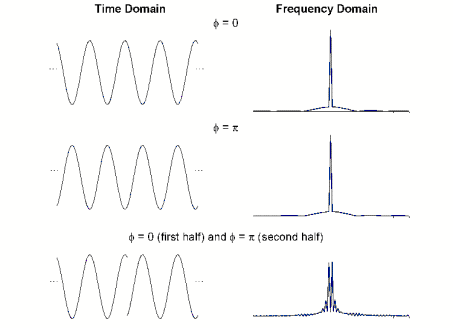
Fig. 5A. Abstract cosine curves with opposite phases (top and middle, left) are characterized by single spectral peaks. Joining
the two curves results in a phase jump of 180° (bottom left). The corresponding spectrum no longer shows a single peak, but
rather two major peaks and several other smaller peaks (bottom).
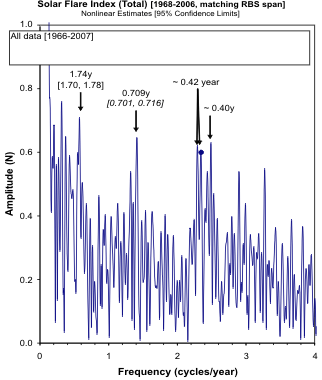
Fig. 5B. Multiple peaklets in the trans- and cis-year and cis-half-year range of the spectrum of solar flares. N=N of flares.


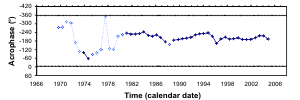

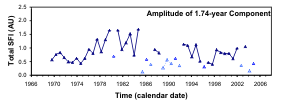


Fig. 5C. The time course of three of the spectral components detected in Fig. 5B is seen to undergo changes in amplitude to
the point that statistical significance is lost (open symbols; rows 2-4, left), and jumps in phase (right).
Comparison of spectral domains
Overdue procedural considerations, as a prerequisite
for rules of behavior, are here presented based on
inferential statistical methods that are themselves a
mere beginning in a temporal microscopy and
telescopy (Halberg 1980, Halberg et al. 2000, 2001,
2008c) that found similarities and differences among
circadian and extra-circadian rhythms. Circadian
cycles in the biosphere are much more often than not
synchronized with a 24-hour environmental period.
Thus, with Dr. Otsuka, a circadian rhythm could be
demonstrated with statistical significance in most
adult subjects in Urausu (SBP: 215/232=92.7%, DBP:
196/232=84.5%, HR: 215/232=92.7%).
The CI of the period covered 24 hours in most
cases, in keeping with the anticipated synchronization
of the circadian system with the environmental
24-hour cycle. Only 17 (7.3%) of the SBP periods
differed from 24 hours. The periods of DBP and HR
differed from 24 hours in 13 (5.6%) and 19 (8.2%)
cases, respectively. The estimated circadian period of
BP or HR did not differ between men and women.
Men had a statistically significantly larger circadian
amplitude of SBP (13.7 vs. 11.1 mmHg) and DBP
(9.0 vs. 7.2 mmHg) than women. Accordingly, the
width of the CI of the period and amplitude was
statistically significantly narrower for men than for
women. No such gender difference was found for HR.
No statistically significant change in the circadian
period of BP or HR was found as a function of age, in
an overall analysis, or in analyses carried out
separately for men or women.
The circadian amplitude of SBP decreased as a
function of age. This decrease was statistically
significant overall (r = -0.176) and for women (r =
-0.202) but not for men. In the case of DBP, the
decrease with age was invariably statistically
significant (overall: r = -0.277; women: r = -0.316;
men: r = -0.220). Consequently, the relative width of
the CI of the circadian amplitude of SBP and DBP
increased with age with statistical significance. No
statistically significant change with age was found for
the circadian amplitude of HR or for the width of its
CI. Whereas no difference in circadian period or
amplitude is found between subjects with or without
a depressed mood for SBP or DBP, in the case of HR,
subjects with a depressed mood have a statistically
significantly longer circadian period (24.25 vs. 23.97
hours). The circadian period of HR is also found to
increase with an increasing GDS score (r = 0.189) and
the circadian amplitude of HR is found to decrease
with an increasing GDS score (r = -0.163).
Infradians (tau>28 hours), like ultradians (tau<20
hours) in the biosphere are often not tightly
frequency-synchronized by environmental cycles.
Vastly different periods show a high degree of
generality, and are important, tipping the scale
between death and survival (Cornelissen and Halberg
1994, Halberg et al. 2006). It is important to
remember that their periods can be non-stationary,
changing with time and hence requiring, whenever
the length of a time series permits, as noted, both a
global and a temporal analysis, the latter by gliding
spectral windows, to track the time course of periods
and to proceed with serial sections at each fixed
frequency of interest.
There is a need to correctly interpret the presence
of multiple spectral peaks that do not invariably
reflect the presence of several components, with
frequencies matching the spectral peaks. For instance,
a jump in phase in the time domain can also account
for multiple spectral peaks, as documented by
simulations, Fig. 5A. A monochromatic signal with a
phase of 0° or 180° is associated with a single
spectral peak (top and middle). When the time
courses are juxtaposed, creating a phase jump, the
spectrum of the resulting time series exhibits multiple
peaks (bottom row). Concrete multiple peaks are
observed in the spectrum of solar flares around 0.42
and 0.40 year, Fig. 5B. They may perhaps correspond
to the phase jumps seen in the time course of the
cis-half-year acrophases of the same data (Fig. 5C,
top row, right). This cis-half-year is also present in
the incidence pattern of human sudden cardiac death
(Halberg et al. 2006), in human circulating melatonin
(Cornelissen et al. 2008), in human SBP and DBP and
in a 15-year series of mostly daily excretions of
urinary 17-ketosteroids, critical for survival and
reproduction (Halberg et al. 2008b).
Maps of congruent periods
It is desirable to test long physiological time series
and, when possible, aligned physical environmental
series for congruence only when the lower limits of
the CIs of the amplitudes of cycles considered do not
overlap zero, i.e., the zero-amplitude assumptions
have been tested and rejected (Halberg 1980,
Cornelissen and Halberg 2005, Refinetti et al. 2007).
The CIs of the periods are then said to be congruent
when their CIs overlie or overlap each other, Figs
6A-E. By a method such as the extended
linear-nonlinear cosinor (Halberg 1980, Cornelissen
and Halberg 2005, Refinetti et al. 2007), as predicted
(Halberg et al. 1991, 2000), we find a set of
congruences of reciprocal periods in and around us,
but not necessarily with congruent phases, Fig. 6F. At
the same periods, we sometimes find clearly divergent
phases, changing gradually up to a point or suddenly,
involving jumps, Fig. 6F (see also Fig. 5C).
In WRB, morning BP measurements show
intra-individual congruence for his SBP and DBP as
well as for body weight in the tridecadal range. Each
variable has a transtridecadal period with a CI
overlapping the range extending from 30 to 40 years,
Fig. 7A (Halberg et al. 2009a). It must be emphasized
that measurements at a fixed time of day cannot be
generalized and that different tridecadal results have
been obtained from time series based on various fixed
times of day from observations on the same person
(Halberg et al. 2008d). Intra-individual transtridecadal
congruence can come about when the point estimates
of periods are close, as is the case for SBP and DBP
of WRB, or because the CIs of the periods are great,
as is the case WRB's body weight.
The SBP of FH exhibits an about 11-year and his
DBP an about 15-year component. FH's HR has an
about 30-year cycle, providing an apparent good fit to
the daily means, Fig. 7B (Halberg et al. 2009c). The
CIs of these three periods do not overlap each other.
Thus, in the sense of overall parameter estimation on
the entire time series, for the same two variables (SBP
and DBP), there can be intra-individual
decadal/multidecadal acongruence (in FH) or
transtridecadal congruence (for WRB). Congruence
can also be tested for a given biospheric cycle with
each solar-ionospheric-terrestrial component, all
summarized with estimates of the uncertainty also of
the period, i.e., with inferential statistical validation
and replication. Thus, for biological variables, we can seek and find counterparts in the cosmos that must
also be examined with their uncertainties, as
examples of transdisciplinary congruence, as shown
for FH in Figs 7C-E. Vice versa, we can look for
markers of environmental cycles in the biosphere.
Reciprocity of periods does not mean any arithmetic
relation. It is no more than the correspondence in
length of periods in us and around us, gauged by their
CIs. There is thus intra-individual congruence (Fig.
7A) or acongruence (Fig. 7B). Some inter-individual
(intra-disciplinary) transtridecadal congruence
characterizes several circulatory variables of WRB,
FH and RBS, three men with long records, as shown
in Fig. 7F for HR of RBS as well as of FH and for
SBP (as well as DBP and body weight) of WRB,
findings showing the need to refrain from
generalizations at this stage of lack of knowledge.
Infradian multidecadal congruence, and accordingly
synchronization are not invariably found.
Intra-individual decadal-multidecadal acongruence
characterizes FH (Fig. 7B), since his SBP, DBP and
HR have no overlapping CIs of their periods. We now
refer to acongruence that can characterize different
variables of the same organism, probably as a result
of a selective environmental congruence, as remains
to be determined for FH, whose SBP perhaps mimics
the long-term course of the Horrebow-Schwabe cycle
in Wolf's relative sunspot numbers (Cornélissen et al.
2009), while his DBP, with a cycle of about 15 years,
perhaps mimics Makarov and Sivaraman's (1989)
global cycle in solar activity and FH's HR reveals an
about 30-year cycle of Bruckner, Egeson and Lockyer, called BEL. Cycles longer than decadal and
shorter than didecadal are also found by S. R.
Prabhakaran Nayar with wavelet analysis in solar
wind proton density and in SWS and based on
linear-nonlinear rhythmometry by ourselves. Linearly,
there is congruence of speed and density for about
17-year components, yet acongruence for
transtridecadals, with the latter lost with the particular
modeling used for FH (Fig. 7B and 7F). Congruence
depends on the period, the time span, the individual(s)
or populations, the variable(s) and spectral regions
considered, Tables 1 and 2.

Fig. 6A. Map of an environmental-biospheric near-transyear (first 9 rows). As a man (GSK) ages and/or his measurement series gets to be
longer, a near-transyear emerges (rows 10a-c).
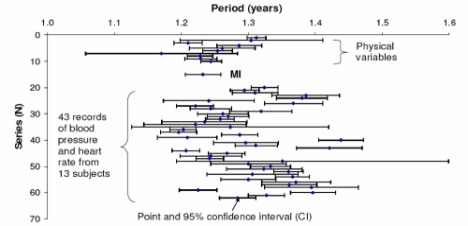
Fig. 6B. Map of environmental-biospheric far-transyears.
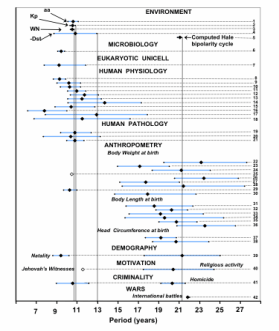
Fig. 6C. Map of environmental-biospheric decadal-didecadal cycles. See Halberg et al. (2002) for key to variables.
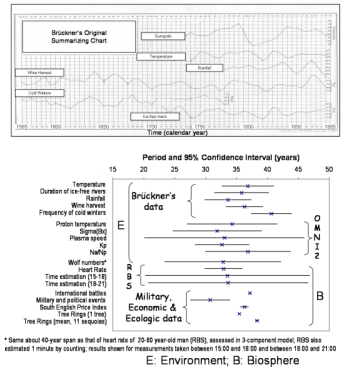
Fig. 6D. Display of original climate data (top) and map of environmental-biospheric transtridecadal Brückner-Egeson-Lockyer (BEL)
cycles (bottom). The BEL cycle in Bruckner's data (first 5 point-and-interval period estimates) is also detected by spectral analysis in military,
economic and ecological data and in physiological data from RBS (see also Fig.s 7I and 7J) and from two
other men (see Fig. 7F), as well as in many other population phenomena, the mechanisms of which become available to study
on individuals for investigators who try to plan beyond their lifespans.
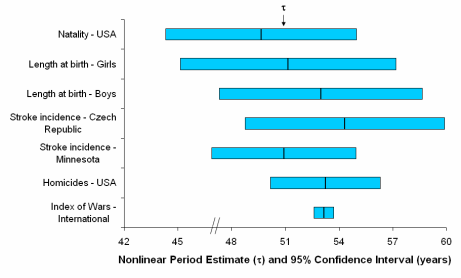
Fig. 6E. Map of environmental-biospheric quindecadal cycle (Halberg et al. 2002).
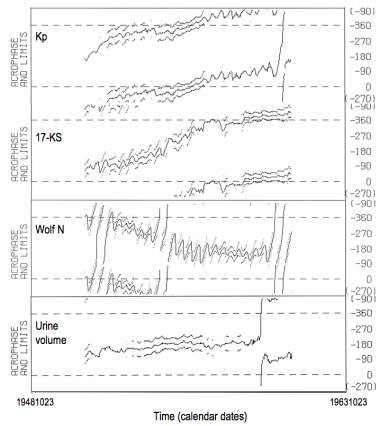
Fig. 6F. Different time course of acrophases from the fit of a 154-day cosine curve among environmental-biospheric cycles
that are congruent in period (latter not shown). Note similar behavior of acrophases of the geomagnetic planetary index Kp and
the urinary excretion of breakdown products of steroidal hormones that, however, differ from the behavior of acrophases of the
same 154-day cosine in Wolf sunspot numbers and in the volume of the urine in which the steroids were determined. Interval
= 5 years; increment = 1 week.
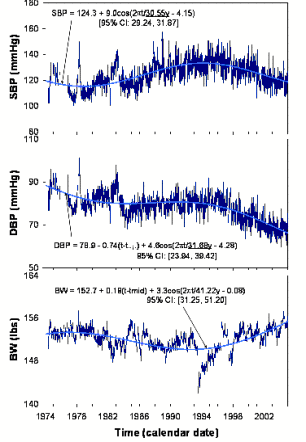
Fig. 7A. Intra-individual transtridecadal congruence of the periods of SBP, DBP and body weight in morning measurements
continued for about 30 years by WRB. Results on DBP and body weight obtained with the concomitant fit of a linear trend. Note
intra-individual differences in acrophase among congruent periods in fitted mathematical models. This multivariable
intra-individual transtridecadal congruence, involving body weight as a gauge of metabolism beyond the circulation, is also
intra-disciplinary, but cannot be generalized to all humans (see Fig. 7B). Nonetheless, transtridecadals (BELs) found in other
biospheric and terrestrial and extraterrestrial climatic variables (see Fig. 6D) render such congruences transdisciplinary as well.
Validation of cyclicity for variables self-measured
by RBS reveals that there is didecadal congruence of
SBP and DBP (Figs 7G and 7H), while there is
acongruence of these two variables with RBS' HR,
Fig. 7I (SBP was acongruent with both DBP and HR
for FH, Fig. 7B). In WRB, there may be tridecadal
congruence of three different variables (Fig. 7A)
during the same time spans that yielded acongruence
for some of the same variables of FH (Fig. 7B), and
intra-individual acongruence for RBS (Fig. 7J) as a
basis for a selective environmental congruence (Fig.
7K). RBS also showed selective congruence in the
para-annual and para-semiannual spectral regions,
Fig. 7L and Tables 1 and 2. From 40 years of
self-measurements of SBP, DBP and HR by RBS,
Fig. 7K reveals global relations (based on analyses of
the entire 40-year series) with the about 10.5-year
cycle in Zurich (Wolf) sunspot numbers (WN), Hale's
about 22-year bipolarity sunspot cycle (BSC,
constituted by changing the sign of WN at consecutive circadecennian WN minima; cf. Prestes
et al. 2006), and the geomagnetic antipodal index aa
(Gaa). The signature of a transtridecadal Bruckner-
Egeson-Lockyer (BEL) cycle, here gauged by WN, found in many climate and biosphere variables, is
congruent with RBS' HR (left), as shown by the
overlying CIs of the about 33-year (BEL) period in
WN and in RBS' HR. The same person's DBP is
congruent (has overlapping CIs of the period of a
spectral component) with Hale's bipolarity cycle
(second shaded pair of CIs of periods in Fig. 7K).
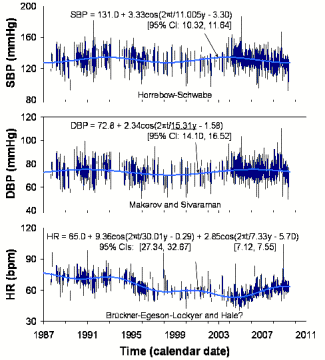
Fig. 7B. Illustration of intra-individual acongruence in the decadal-multidecadal spectral region of FH.
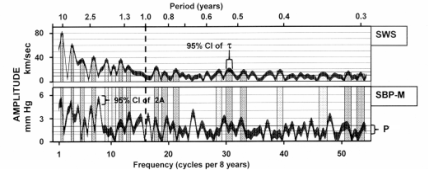
Fig. 7C. Solar wind speed's congruences with SBP of FH.
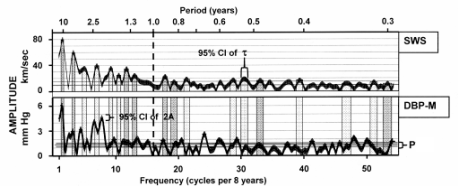
Fig. 7D. Solar wind speed's congruences with DBP of FH.
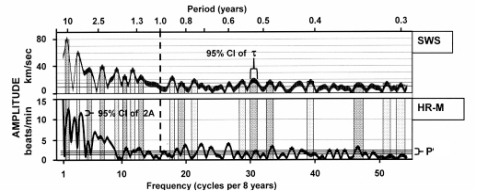
Fig. 7E. Solar wind speed's congruences with HR of FH.
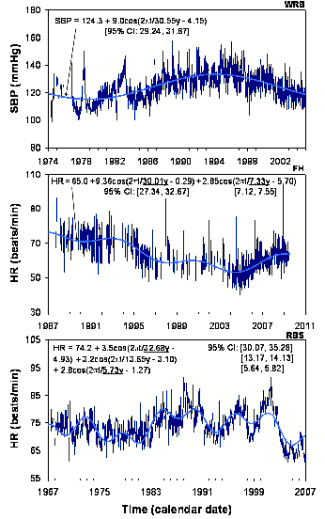
Fig. 7F. Inter-individual transtridecadal congruence of different variables in the circulation of blood in three men, RBS vs. WRB (see Fig.
7A) and FH (see Fig. 7B).
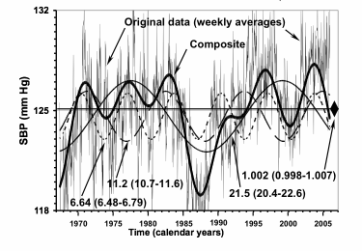
Fig. 7G. For RBS's SBP, a didecadal cycle with a period of about 21.5 years, apparent in the original data, covers, with its CI, the period
estimate of his DBP, shown in Fig. 7H.
DISCUSSION
Many long time series are needed to systematically
examine any intra-disciplinary congruence or
acongruence at each period, globally and
time-varyingly in different variables of the same
discipline, such as physiology, pathology or
sociology. In the only three cases available to us
covering a sufficiently long span to detect tridecadals,
this BEL cycle was found in one (RBS and FH) or
three variables (WRB). Intra- and inter-individual
congruences and other intra-disciplinary congruences
are best explored prior to examining any congruence
of periods in two or more disciplines for
interdisciplinary congruences between two disciplines
and further for the transdisciplinary ones among many
more fields, Fig. 7K. For the BEL cycle, trans-disciplinarity has been extensively documented
(Halberg et al. 2009d).
Periods in the biosphere congruent with
overlapping if not overlying uncertainty with helio- or
geomagnetics are found in several different spectral
regions of a given variable or system of variables.
Transdisciplinary congruences of periods are also
found in the usually 24-hour synchronized circadian
and about 7-day (circaseptan) systems, in about
5-month (cis-half-year) (Cornelissen et al. 2008) and
6-month (Cornelissen et al. 2003) systems, and are
documented in the transyear (Halberg et al. 2003b,
Cornelissen et al. 2004, 2007a, Kovac and Mikulecky 2005, 2006, Mikulecky and Florida 2005, Mikulecky
2006) and circasemimillennial (Halberg et al. 2004,
Mikulecky 2007) spectral regions, to cite but a few
examples.
Overlapping CIs of periods in and around us are
selective insofar first as in the same person (RBS) the
same biotic variable can be congruent with a solar
variable at one frequency and with a terrestrial
variable at another. Major environmental cycles such
as those of about 30 and about 20 years can have
different biotic counterparts in BP versus HR, as
reciprocal periods, all facts of the selective assortment
characterizing our cosmic inheritance of cycles, Fig.
7K. In other regions of the spectrum, such as the para-annual and para-semiannual regions, in the range
of periods between 0.3 and 2.0 years, there is biotic
congruence with one or both, helio- and geomagnetics
or with neither. As seen in Fig. 7K, in Tables 1 and 2
and in Figs 6A, 6B and 7C-E, a congruence of
periods is found in the para-annual and para-semiannual regions of the spectrum, very often
with SWS or with geomagnetism, the latter gauged by
the antipodal index aa, for a human mental function
(the estimation of 1 minute) carried out
around-the-clock on most days for well over 3.5
decades. Overall, there is the anticipated congruence
between periods in SWS and aa in 24% of the cases,
insofar as 5 of the 21 spectral peaks in SW have a
counterpart in aa, once we restrict focus upon the
para-annual and para-semiannual spectral regions.
There is actually congruence in 29% insofar as 5 of
the 17 SWS peaks have aa counterparts for a mental function, the estimation of 1 minute, in this region, as
can be seen from Table 1 and Fig. 7L. Table 2 shows
further congruences of psycho-physiologic variables
with SWS and/or aa.
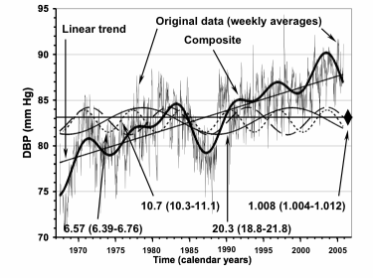
Fig. 7H. For RBS's DBP, a didecadal cycle with a period of about 20.3 years, complicated by a linear trend, covers, with
its CI, the period estimate of his SBP, shown in Fig. 7G.

Fig. 7I. For RBS's HR, there is no trace of a didecadal cycle seen in Fig. 7G and 6H for his SBP and DBP.

Fig. 7J. Intra-individual acongruence, a requirement for selective biospheric-environmental congruence (see Fig. 7K).
Rules of cycles' inheritance from the cosmos
Endogenicity was clear for some ultradian rhythms,
as in the case of cardiac cells beating in vitro (Han et
al. 1991) or of the heart in toto doing so. The built-in
nature of circadians was documented by statistically
significant intra-class correlation coefficients of the
MESOR, amplitude and acrophase of HR of
monozygotic twins reared apart, many of whom met
for the first time in Minnesota (Hanson et al. 1984),
Figs 8A-C. Our inferential statistical documentation
of periods longer than 28 hours, up to over 30 years
by both global and time-varying analyses allows a
summary herein of the rules of inheritance of
infradian biospheric cycles that mimic those of the
cosmos.
Rule 1, indispensable but not sufficient, is
congruence in period, not necessarily in phase,
documented by overlapping CIs of infradian periods,
in various regions of the spectra from multiples and
submultiples of 7 days (multiseptans) up to periods
longer than 30 years (transtridecadals). In the case of
decadals, notably of transtridecadals, a documentation
of the rule of a minimum of three cycles needed to
document a rhythm can be sought (and was found)
transversely across three individuals, rather than
longitudinally in the same individual, as seems
reasonable, even for centenarians. Likely changes
with age in the cycles' behavior found for transyears
remain to be documented for decadals and
multidecadals.
Rule 2 is a selective assortment of the
biospheric-cosmic pairing differing among
individuals, e.g., of HR with a transtridecadal
environmental cycle and of BP with a didecadal cycle
in RBS or of SBP with a Horrebow-Schwabe decadal
cycle, DBP with putatively a global cycle, and HR with a BEL likely in FH. By reference to these first
two rules, we are influenced by Mendel's laws of
segregation and independent assortment of what
became genes.

Fig. 7K. Selective environmental congruence seen for RBS.

Fig. 7L. Congruence between the magnetism of earth and sun (columns 1-2) vs. congruence of helio- or geomagnetics with
a human mental function (columns 3-10). Note numerically higher percentage of congruence between either helio- or
geomagnetics and the biosphere as compared to congruence between solar and terrestrial magnetism. PA/SA: para-annual/semi-annual spectral
region.
Rule 3, a "consistent subtractive and/or additive
behavior", was examined when the opportunity arose
by subtraction (up to removal) from and/or addition to
the transdisciplinary spectrum of an environmental
component to determine whether it entailed
corresponding changes (damping or amplification,
Fig. 8D, or pull of phase, Fig. 8E) in the biosphere.
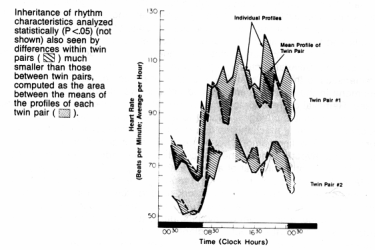
Fig. 8A. Circadians were documented as inherited by intra-class correlation coefficients (r) (all statistically significant) of
the MESOR, amplitude and acrophase of HR (monitored for 24 hours beat-to-beat) of monozygotic twins reared apart, many of
whom met for the first time in Minnesota. The computation of rI demonstrates heritability separately for each characteristic.
Heritability was documented earlier indirectly by studies of a free-running rhythm during human isolation for several months
in a cave. This Fig. is oversimplified, conveying the concept of inter- and intra-twin-pair variability with data from only two pairs
of twins. In order to obtain a valid estimation of the inheritance of circadian rhythm characteristics of HR, data from a larger
number of twin pairs are needed. A summary of results from 21 twin pairs serves this purpose. The result of a statistical
computation (of r) indeed documents a genetic basis for three circadian rhythm characteristics of human HR.
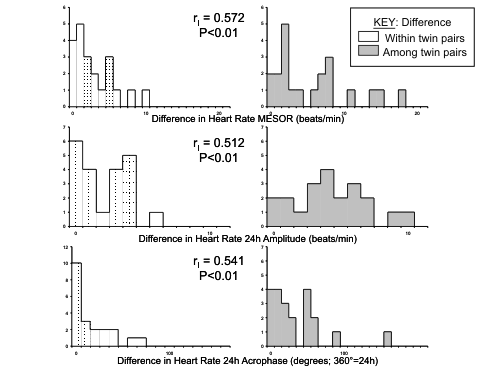
Fig. 8B. The results from monozygotic twin pairs reared apart. At the time of study, they had a mean age of 32.8 years. Their
mean age of reunion was 16.1 years, and they were on the average 2.9 months old at separation. Half the sets were studied within
6 months of finding each other. Each twin of a pair was monitored during the same week, although not necessarily on the same
day.
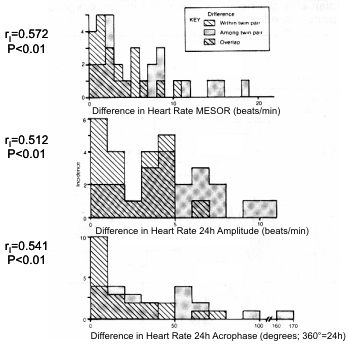
Fig. 8C. The intra-class correlation coefficient (rI) is used herein to test the heritability of circadian rhythm characteristics of
human HR. Heritability is demonstrated for all three parameters, MESOR (M), amplitude (A) and acrophase (phi) (all statistically
significant).

Fig. 8D. A lesser prominence of an about 7-day spectral component in the HR of 5 men is found when the solar wind loses
its counterpart (left). Implied, but not shown, is the persistence in the biosphere of an about 7-day component that can be driven
(amplified) by a reciprocal component in solar activity. There is partial resonance of the about 1.3-year component in the SBP
of FH with SWS (middle). Non-stationary intermittent frequencies are seen to characterize SWS (top row). These, like those in
SBP, are called Aeolian (derived, as a personification of the solar wind, as Aeolus, Greek ruler of winds), the use of the term
implying, however, that interval as well as point estimates of the periods are provided, at least globally and, whenever desirable,
time-varyingly in chronomic serial sections, complementing gliding windows. SWS, like SBP, changes in frequency, smoothly
[A] or abruptly [B, C, D], bifurcating [D, F] and rejoining [G], and varies in amplitude [B], up to disappearing [C, E] and
reappearing. An abrupt change in SWS is followed in SBP with a lag by changes such as the narrowing (disappearance of part)
of a broad band and the damping of the remaining part of the about 1.3-year [1.22- to 1.38-year] far-transyear component in SBP,
previously congruent with a counterpart in SWS and by the disappearance of part of a cis-year. This finding suggests that some
of FH's cis- and transyear components were driven by the solar wind. Note also that part of a far-transyear band disappeared with
a lag of about a far-transyear following the disappearance (subtraction) of the same components from the SWS spectrum. The
lag in the disappearance from SBP of a cis-year component of about 0.66 year is the same (not shorter) as that for the transyear,
suggesting the possibility that it represents a harmonic of a non-sinusoidal far-transyear. Specifically, after the broad band
disappears in the SWS (at E), parts of the same broad band in SBP also disappear, with a lag (delay) at E', while other parts,
albeit damped, persist. This persistence of a narrower damped band in the spectral domain suggests prior driving of a component
with partial endogenicity, i.e., an evolutionary acquisition of biotic transyear oscillations that may reflect solar dynamics for the
past billions of years. Post hoc ergo propter hoc reasoning can never be ruled out. N=2,418 daily averages of BP and HR data;
total N=55,000, from automatic around-the-clock monitoring for nearly 16 years, mostly at 30-min intervals, with interruptions.
Gliding spectra computed with an interval of 8 years have a resolution low in time but high in frequency. The increment is 1
month and trial periods range from 2.5 to 0.4 year(s), with a harmonic increment of 0.05. Darker shading corresponds to larger
amplitudes. Congruence in both time and frequency is found for the about 1.3-year component of terrorism with respect to both
SWS and aa (right). Peaks of best fitting cosine curves (phis) and parts of chronomic serial sections show a statistically significant
about 1.3-year far-transyear in both SWS (top) and in the antipodal geomagnetic index aa (middle), followed on each of two
occasions with a lag by a statistically significant about 1.3-year component in terrorism which by far outlasts the apparently
triggering putative heliogeomagnetic drivers (phis are plotted only when the 1.3-year amplitude differed from zero with statistical
significance, as shown by dots bracketing the point estimates of the acrophase, indicative of the CIs of phis in each interval).
Noteworthy further, but not shown, is that a transyear replaces the calendar year in a 39-year series of terrorist acts, suggesting
the importance of transyears in military-political affairs, with the same finding of a transyear, as a replacement of the seasons,
in the popularity of a U.S. president. These and/or other non-photic signatures pervade human affairs, including military and
political activity, economics and health. Transyear and cis-half-year patterns are pertinent to sudden cardiac death, a condition
wherein magnetic storms may be protective rather than noxious.
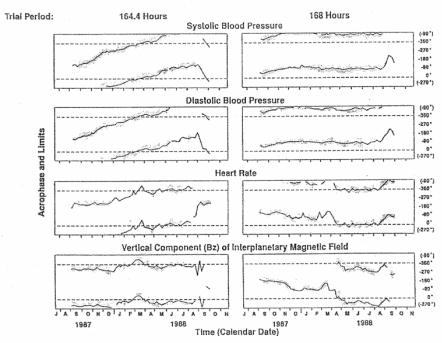
Fig. 8E. Chronobiologic serial sections carried out at a trial period of 164.4 hours (left), corresponding to the period of the
north-south component (Bz) of the interplanetary magnetic field (IMF) (bottom), and at a trial period of 168 hours (7 days),
corresponding to the societal week (right). BP and HR were measured ambulatorily around the clock, mostly at 15-minute
intervals for about 16 months by a woman 67 years of age at the start of monitoring (rows 1-3). Thicker line segments indicate
statistical significance as do dots bracketing the acrophases (phis), corresponding to their CIs. The circaseptan component is mostly
statistically significant for all variables, at both trial periods. The acrophase curve of Bz is horizontal (stable) at a trial period of
164.4 hours, whereas the acrophase curve of BP is more or less horizontal at a trial period of 168 hours. For HR, the time course
of acrophases drifts with the 168-hour trial period. The physiological variables are differently synchronized, BP mainly by the
societal week and HR pulled by the 164.4-hour period of Bz. In the case of HR, a small acrophase shift occurs more or less in
the middle of the monitoring span. This shift in circaseptan acrophase of HR coincides with a similar shift in circaseptan
acrophase of Bz. BP clearly drifts away from 164.4 hours (left), further validating the 7-day synchronized component in BP. In
the case of HR, there is also a transient drift of the acrophase of the 164.4-hour component for several months, but it is not as
pronounced or consistent as that observed for BP. Moreover, there are spans when the 164.4-hour acrophase remains stationary
at the beginning of the series and again in the second half of the monitoring span. These are spans when a stable 164.4-hour
acrophase is also observed for Bz. From these observations, it appears that Bz may pull HR, and that there is occasional
phase-locking as well as period-locking between these two variables. It should be noted further that the acrophase difference
between HR and Bz at the beginning of the series is about 90°, whereas in the second half of the series the acrophase difference
is smaller. This means that when there is frequency-locking between the two variables, this may occur with a different phase
difference. Whether or not these phase differences and phase-locking follow a predictable pattern such as being dependent upon
the stage of the solar activity cycle remains to be further investigated. These results are only observational at this stage, and a
mechanism or model accounting for these observations has not yet been developed. One avenue that seems promising may be
to consider the possibility that there is more than a single circaseptan component in geomagnetic disturbance. This was the case
for geomagnetic pulsations in Antarctica as well as in geomagnetic indices during some but not all spans that were investigated
since the recording of aa (and later of Kp) started. One component was close to 7 days and the other was slightly shorter than
7 days. When two components with close periods are present jointly, they may pull during some spans, but not during others,
depending upon the relative instantaneous phase difference between the two different components, e.g., whether they are in phase
or out of phase.

Fig. 8F. We need not ignore the many signatures of the cosmos with validated statistical significance of anticipated periods
that characterize:
a. dozens of decades-long time series of BP and HR;
b. other physiology and psychology, including mental functions;
c. religious proselytism;
d. suicide;
e. sudden cardiac death;
f. terrorist activity for the past 39 years;
g. 2,556 years of international battles compiled by Raymond Holder Wheeler;
h. military expenditures for training in non-medical science;
i. degrees earned;
j. Gallup Polls;
k. political and military actions in nearly 200 years, meta-analyzed from the much broader treasure of data compiled by Alexander
Leonidovich Chizhevsky (1921).
While chance can never be ruled out, it would be further greatly reduced by systematic lifetime monitoring of physiology in health, of pathology
and disease, notably in archives to separate effects of sun and earth, many of which are beneficial. Other effects such as extreme cold and heat
or extreme light can be met by countermeasures such as housing, heating and air conditioning. The task remains to develop countermeasures to those
non-photic effects that can be documented as harmful. While the earth is the immediate actor, and for that action the sun is the modulator, while
the biosphere reacts to both terrestrial and solar factors, the roles of actor, reactor and modulator are continuously changing. In the greenhouse
effect, organisms are the actors, as shown by a double-headed arrow (B2). There may be other more subtle effects of synchronized human action upon
the earth. Original drawing by Mary Sampson.
Rule 4 is the genetic coding of the biospheric
cycle, revealed at the molecular level for circadians
and perhaps at the atomic level (Ulmer et al. 1995) for
some circaseptans and for other infradians as yet only
by rule 3, the damping, yet persistence, following the
removal of a corresponding environmental
component. This rule validates the long-term occurrence of an environmental cycle by the point
that it became genetically coded. Damped persistence
of the biospheric cycle is a transdisciplinary tool
equally pertinent to physics and biology.
Congruence and its selectivity, in the light of
subtractive and additive behavior, that assesses the
roles of factors from outside vs. inside the biosphere,
gain in importance, when the biotic cyclic partner
relates to:
1) THE HEALTH of individuals with its alterations
serving as early harbingers of risk that prompt
measures for stroke and other severe disease
prevention (as is the finding of Vascular
Variability Disorders, VVDs, pertaining notably
to alterations of the circadian rhythm, such as a
BP overswing that carries a risk of developing a
cerebral ischemic event in the next 6 years greater
than that of an elevated BP itself and can often be
treated) (Halberg et al. 2009b) and to
2) THE DISEASES of society, being reflected in the
incidence patterns of sudden cardiac death
(Halberg et al. 2006), suicide (Cornelissen and
Halberg 2006, Halberg et al. 2008a), crime and
terrorism (Cornelissen et al. 2007b, Grigoryev and
Vladimirskii 2007, Halberg et al. 2007), and
possibly leading to measures such as the
optimization of the desirable (good) and the
elimination, as far as possible, of the undesirable
(evil) by appropriate countermeasures.
Rational mechanisms that have to be tested to
inquire about causality depend on a
subtraction-addition (remove and replace) approach
implemented by the cosmos and have thus far shown
the persistence with damping of the biotic spectral
components when a reciprocal environmental
component was lost or buried in noise to the point
that it was no longer detectable by available methods
and/or there was amplification when the
environmental spectral component, previously not
detected, became statistically significant, Fig. 8D and
8E (Cornélissen et al. 1996, Halberg et al. 2006,
Sothern et al. 2009b).
Epilogue on method: remove and replace =
subtraction and addition in the study of biological
circadian rhythms
Removing a gland was a time-honored approach to
finding out what the removed gland does, by looking
for deficiencies or other alterations and seeing further
what replacement of the gland (by transplantation or
its hormones) does. This was how endocrinology was
reportedly founded by Berthold (1849, 1880). Two
cockerels with their testicles removed remained
capons (subtraction); two other castrated cockerels
(remove = subtraction) that received testicular
transplants (replace = addition) developed secondary
sexual characteristics, and the concept of substitution
therapy evolved.
In 1950, one of us (FH) reported, as others did
before him, very large variations along the 24-hour
scale in counts of cells staining with a pink dye
(eosin): the eosinophil cells (Halberg and Visscher
1950). He also found differences in this variability as
a function of genetics. Moreover, the eosinophil
counts were depressed by certain adrenocortical
hormones and by epinephrine in the presence and in
the absence of the adrenal cortex as found in mice
(Halberg 1952) with a focus upon the role of chemical
structure in exogenous eosinopenia. Best et al. (1952)
reported the finding that the eosinophil response to
epinephrine persisted in patients with their adrenal
glands removed (as found in mice by one of us, FH).
In the euphoria of the finding that the adrenal
hormone made lame people walk again, adrenal
glands were removed in research on humans looking
for mechanisms underlying the effect of these
"wonder drugs". The opportunity to study patients
deprived of their adrenals, a rare event in the history
of medical science, revealed that a cycle in eosinophil
count was lost in patients (Halberg et al. 1951, cf.
Best et al. 1952) without adrenals, as it was lost in
adrenalectomized mice (Halberg et al. 1953). The
finding held for the circadian rhythm of eosinophil
cell counts. In the circadian rhythm of serum iron,
there were only changes of the amplitude and the
acrophase, after adrenalectomy, but there was no
abolition of this rhythm. Some decades later, the
ablation of the suprachiasmatic nuclei abolished the
circadian rhythm in water drinking, but not that in
alcohol drinking or in DNA labeling in the digestive
tract, or core temperature (Cornelissen and Halberg
1994, Cornelissen et al. 2002).
The team of Jerome W. Conn (of Conn Syndrome
fame) confirmed the finding in adrenocortical
insufficiency of the eosinophil rhythms'
disappearance and showed, in addition, that
replacement with a single large dose at the right time,
but not with divided smaller doses, of oral cortisone
re-induced the rhythm (Kaine et al. 1955). The
approach by "remove" (subtraction) was thus again
complemented by "replace" (addition). The approach
by subtraction was extended in the earliest 1950s
beyond gland removal to the study of other
mechanisms of the eosinophil rhythm. When the eyes
(receptors of a synchronizing lighting cycle) were
"subtracted" by surgery or genetics (in ZRD mice
born blind), a previously 24-hour synchronized cycle
in activity, while it did not disappear, was
free-running from the 24-hour routine, with a built-in
near 1-day, but not of precisely 24-hour length
(Halberg 1954, Halberg et al. 1954). A circadian
desynchronization was already documented by
periodograms (that took a week to compute on a desk
calculator and another week to check) and were the
topic of a discussion by FH with Julius Bartels in
1953 (Halberg 2000), to indicate that the latter's
harmonic dial could also be used flexibly for fitting
anticipated desynchronized environmental cycles and
not necessarily only a precise 1-year or 1-day period.
"Circadian" was coined - in the early 1950s, and
endorsed by international nomenclature committees
years later (Halberg 1959) - both to indicate partial
endogenicity and (another reason for "circa" that is
too often forgotten) to refer to the also-encountered
variability inherent in the cycle's characteristics.
"Circadian" was intended to replace "diurnal", a term
used in medicine and zoology to distinguish activity
or morbidity patterns during the daily photofraction
from those during the daily scotofraction, as
diurnality vs. nocturnality, respectively. While they
are obvious signatures of the photic day, circadians
are also influenced non-photically by natural and
artificial electric fields (Wever 1979) and by subtle
environmental factors in caves (Halberg et al. 1998).
Circadian timing accounts for the difference between
about 75% survival vs. about 75% death from the
same dose of a cardiac drug, among others, under
controlled laboratory conditions as a function of
timing (Halberg and Stephens 1959).
In dealing with diseases of society, the
environmental global monitoring started with
magnetometers by Gauss, Humboldt and Sabine must
be extended to humans, in order to understand,
eventually to treat and ideally to prevent diseases of
society. Here the remove-and-replace approach has its
precedence in air conditioning to remove undue heat
and heating to replace lacking acceptable
temperatures. Just as the cosmos determines
temperatures, it also has effects that we can study as
a follow-up on the remove-and-replace approach in
endocrinology, chronomics and environmental
temperature control in homes and eventually in
habitats. For instance, it has been shown that
circaseptans in human HR are expressed more
prominently when this component is detectable in the
rate of change in sunspot area (Cornélissen and
Halberg 1994, Cornelissen et al. 1996).
CONCLUSION
We systematically monitor climate for physical
variables related to weather. In human affairs,
surveillance is extended to garages to prevent crimes,
and small rodents to develop drugs, but not those for
whom the drugs are intended. It took over half a
century before voices to monitor blood sugar of
patients with insulin-dependent diabetes were heard.
Monitoring BP is equally timely, technically feasible
for individualized improved home and website-based
personalized care, while also serving basic science.
Someday perhaps the prevention of societal illness, a
task for scholars of the geo- and cosmo-physical as
well as of biomedical sciences will be implemented
by and for every person, just as alphabetism, the
fourth "R" for rhythm in education has become a
universal desideratum. It took a long time for
antisepsis to become accepted. Just as one bacterium
can multiply and lead to severe sepsis or as one
cancer cell can develop into a lethal malignancy, so
one pathogenetic individual can "infect" a population
and lead to disaster in populations. It is the more
urgent to identify and separate, by congruence and
"remove and replace" approaches the
helio-geomagnetic and other influences that unseen
act powerfully upon us, Fig. 8F, contributing in
certain geographic regions to the patterns of sudden
cardiac death, suicide and terrorism.
ACKNOWLEDGEMENT
GM-13981 (FH) and University of Minnesota Supercomputing Institute (GC, FH).
REFERENCES
Bartels J. Statistical studies of quasi-periodic variables: with illustrative examples from geophysics (Reprints of three papers from Terr Mag Atmosph Electr). Carnegie Institution of Washington, Washington DC 1959.
Berthold AA. Fragment einer Selbstbiographie von Arnold Adolph Berthold. Deut Arch Gesch Med med Geogr. 3: 74-100, 1880.
Berthold AA. Transplantation der Hoden. Arch. Anat. Physiol. Wissenschr. Med., 1849, pp. 42-46; translated by Quiring DP, Transplation of Testes. Bull Hist Med. 16: 339-401, 1944.
Best WR, Muehrcke RC, Kark RM. Studies on adrenocortical eosinopenia: a clinical and statistical evaluation of four-hour eosinophil response tests. J Clin Invest. 31: 733-742, 1952.
[CrossRef]
[PubMed]
Broda H, Brugge D, Homma K, Hastings JW. Circadian communication between unicells? Effects on period by cell-conditioning of medium. Cell Biophys. 8: 47-67, 1986.
[PubMed]
Chibisov SM. Resolution concerning chronobiology and chronomics. III International Conference, Civilization diseases in the spirit of V. I. Vernadsky, People's Friendship University of Russia, Moscow, Oct. 10-12, 2005, p. 23-25.
Chizhevsky AL. Astronomy, Psychology and History. M. A. Institute, Moscow 1921, 78 pp.
Cornelissen G, Halberg F. Introduction to Chronobiology. Medtronic Chronobiology Seminar #7, April 1994, 52 pp.
Cornelissen G, Halberg F. Chronomedicine. In Armitage P, Colton T (eds.): Encyclopedia of Biostatistics, 2nd ed. John Wiley & Sons Ltd, Chichester 2005, p. 796-812.
[CrossRef]
Cornelissen G, Halberg F. Chronomics of suicides and the solar wind. Br J Psychiatry. 189: 567-568, 2006.
[CrossRef]
[PubMed]
Cornelissen G, Broda H, Halberg F. Does Gonyaulax polyedra measure a week? Cell Biophys. 8: 69-85, 1986.
[PubMed]
Cornelissen G, Halberg F, Wendt HW, Bingham C, Sothern RB, Haus E, Kleitman E, Kleitman N, Revilla MA, Revilla M, Jr., Breus TK, Pimenov K et al. Resonance of about-weekly human heart rate rhythm with solar activity change. Biologia (Bratisl). 51: 749-756, 1996.
Cornelissen G, Kanabrocki E, Halberg J, Halberg F. Toward the chronobiology and chronomics of the intestine. In Zabielski R, Gregory PC, Westrom B (eds.): Biology of the Intestine in Growing Animals. Elsevier NV, Amsterdam 2002, p. 751-804.
[CrossRef]
Cornelissen G, Halberg F, Pollmann L, Pollman B, Katinas GS, Minne H, Breus T, Sothern RB, Watanabe Y, Tarquini R, Perfetto F, Maggioni C et al. Circasemiannual chronomics: half-yearly biospheric changes in their own right and as a circannual waveform. Biomed Pharmacother. 57 (Suppl. 1): 45s-54s, 2003.
[CrossRef]
Cornelissen G, Masalov A, Halberg F, Richardson JD, Katinas GS, Sothern RB, Watanabe Y, Syutkina EV, Wendt HW, Bakken EE, Romanov Y. Multiple resonances among time structures, chronomes, around and in us. Is an about 1.3-year periodicity in solar wind built into the human cardiovascular chronome? Human Physiol. 30: 86-92, 2004.
[CrossRef]
Cornelissen G, Halberg F, Rostagno C, Otsuka K. A chronomic approach to cardiac arrhythmia and sudden cardiac death. Auton Nerv Syst. 44: 251-254, 2007a.
Cornelissen G, Halberg F, Wendt HW, Sothern RB, Chibisov SM, Kulikov SI, Agarwal RK. Weak magnetoperiodism rather than socio-photo- thermoperiodism characterizes human terrorism detection of about 1.3-year aeolian transyear but not precise 1.0-year cycle. In Frolov VA, Grinina OV, Agarwal RK (eds.): Proc. 8th Intern. Congr. “Health and Education in XXIst Century”, Moscow, Russia, November 14-17, 2007b, p. 77-80.
Cornelissen G, Tarquini R, Perfetto F, Otsuka K, Gigolashvili M, Halberg F. About 5-month cycle in human circulating melatonin: signature of weather in extraterrestrial space? Poster presentation, Fourth UN/ESA/NASA/JAXA Workshop on the International Heliophysical Year 2007 and Basic Space Science: "First Results from the International Heliophysical Year 2007", Sozopol, Bulgaria, June 2-6, 2008.
Cornelissen G, Halberg F, Sonkowsky R, Siegelova J, Homolka P, Dusek J, Fiser B. Meta-analysis of Horrebow's and Schwabe's scholarship with a view of sampling requirements. In Halberg F, Kenner T, Fiser B, Siegelova J: Proc. Noninvasive Methods in Cardiology, Brno, Czech Republic, July 7-10, 2009, p. 141-158.
Dewey ER, Mandino O. Cycles: The Mysterious Forces That Trigger Events. Hawthorn, New York 1971, 211 pp.
Ertel S. Space weather and revolutions: Chizhevsky's heliobiological claim scrutinized. Studia Psychol (Bratisl). 39: 3-22, 1996.
Fraser-Smith AC. Spectrum of the geomagnetic activity index Ap. J Geophys Res. 77: 4209-4220, 1972.
[CrossRef]
Grigoryev PYe, Vladimirskii BM. The cosmic weather affects the terrorist activity. Uchenye zapiski Tavricheskogo Natsionalnogo Universiteta im V. I. Vernadskogo, Series "Biology, chemistry" 20 (59) (No. 1): 28-46, 2007.
Halberg F. Some correlations between chemical structure and maximal eosinopenia in adrenalectomized and hypophysectomized mice. J Pharmacol Exp Ther. 106: 135-149, 1952.
[PubMed]
Halberg F. Beobachtungen uber 24 Stunden-Periodik in standardisierter Versuchsanordnung vor und nach Epinephrektomie und bilateraler optischer Enukleation, 20th meeting of the German Physiol. Soc., Homburg/Saar, September, 1953. Berichte über die gesamte Physiologie und experimentelle Pharmakologie (Berichte uber die gesamte Biologie, Abteilung B) 162: 354-355, 1954. [English translation of Aschoff's remark in Halberg F et al. Transdisciplinary unifying implications of circadian findings in the 1950s. J Circadian Rhythms. 1: 2, 2003. 61 pp, see p. 23.].
Halberg F. Physiologic 24-hour periodicity; general and procedural considerations with reference to the adrenal cycle. Z Vitamin, Hormon Fermentforsch. 10: 225-296, 1959.
Halberg F. Chronobiology: methodological problems. Acta Med Rom. 18: 399-440, 1980.
Halberg F. Historical encounters between geophysics and biomedicine leading to the Cornelissen-series and chronoastrobiology. In Schroder W (ed.): Long- and Short-Term Variability in Sun's History and Global Change. Science Edition, Bremen 2000, p. 271-301.
Halberg F, Visscher MB. Regular diurnal physiological variation in eosinophil levels in five stocks of mice. Proc Soc Exp Biol (NY). 75: 846-847, 1950.
Halberg F, Stephens AN. Susceptibility to ouabain and physiologic circadian periodicity. Proc Minn Acad Sci. 27: 139-143, 1959.
Halberg F, Conner RL. Circadian organization and microbiology: Variance spectra and a periodogram on behavior of Escherichia coli growing in fluid culture. Proc Minn Acad Sci. 29: 227-239, 1961.
Halberg F, Visscher MB, Flink EB, Berge K, Bock F. Diurnal rhythmic changes in blood eosinophil levels in health and in certain diseases. J Lancet. 71: 312-319, 1951.
[PubMed]
Halberg F, Visscher MB, Bittner JJ. Eosinophil rhythm in mice: Range of occurrence; effects of illumination, feeding and adrenalectomy. Amer J Physiol. 174: 109-122, 1953.
[PubMed]
Halberg F, Visscher MB, Bittner JJ. Relation of visual factors to eosinophil rhythm in mice. Amer J Physiol. 179: 229-235, 1954.
[PubMed]
Halberg F, Johnson EA, Nelson W, Runge W, Sothern R. Autorhythmometry - procedures for physiologic self-measurements and their analysis. Physiol Teach. 1: 1-11, 1972.
Halberg F, Breus TK, Cornelissen G, Bingham C, Hillman DC, Rigatuso J, Delmore P, Bakken E. International Womb-to-Tomb Chronome Initiative Group: Chronobiology in space. Keynote, 37th Annu. Meet. Japan Soc. for Aerospace and Environmental Medicine, Nagoya, Japan, November 8-9, 1991. University of Minnesota/Medtronic Chronobiology Seminar Series, #1, December 1991, 21 pp.
Halberg F, Cornelissen G, Sonkowsky RP, Lanzoni C, Galvagno A, Montalbini M, Schwartzkopff O. Chrononursing (chronutrics), psychiatry and language. New Trends Exp Clin Psychol. 14: 15-26, 1998.
Halberg F, Cornelissen G, Otsuka K, Watanabe Y, Katinas GS, Burioka N, Delyukov A, Gorgo Y, Zhao ZY, Weydahl A, Sothern RB, Siegelova J et al. International BIOCOS Study Group. Cross-spectrally coherent ~10.5- and 21-year biological and physical cycles, magnetic storms and myocardial infarctions. Neuro Endocrinol Lett. 21: 233-258, 2000.
[PubMed]
Halberg F, Cornelissen G, Otsuka K, Schwartzkopff O, Halberg J, Bakken EE. Chronomics. Biomed Pharmacothe.r 55 (Suppl. 1): 153s-190s, 2001.
[CrossRef]
Halberg F, Cornelissen G, Katinas G, Appenzeller O, Otsuka K, Sothern RB, Tarquini R, Perfetto F, Maggioni C, Wilson D, Schroder W, Schwartzkopff O et al. System times and time horizons for biospheric near-matches of primarily non-photic environmental cycles. Biomed Pharmacother. 56 (Suppl. 2): 266s-272s, 2002.
[CrossRef]
Halberg F, Cornelissen G, Bingham C, Witte H, Ribary U, Hesse W, Petsche H, Engebretson M, Geissler H-G, Weiss S, Klimesch W, Rappelsberger P et al. Chronomics: Imaging in time by phase synchronization reveals wide spectral-biospheric resonances beyond short rhythms. ("Wenn man uber kurze Rhythmen hinausgeht") In memoriam - lost future: Dr.-Ing. habil. Dr. rer. nat. Barbara Schack: 1952-2003. Neuro Endocrinol Lett. 24: 355-380, 2003a.
[PubMed]
Halberg F, Cornelissen G, Schack B, Wendt HW, Minne H, Sothern RB, Watanabe Y, Katinas G, Otsuka K, Bakken EE. Blood pressure self-surveillance for health also reflects 1.3-year Richardson solar wind variation: spin-off from chronomics. Biomed Pharmacother. 57 (Suppl. 1): 58s-76s, 2003b.
[CrossRef]
Halberg F, Cornelissen G, Regal P, Otsuka K, Wang ZR, Katinas GS, Siegelova J, Homolka P, Prikryl P, Chibisov SM, Holley DC, Wendt RW et al. Chronoastrobiology: proposal, nine conferences, heliogeomagnetics, transyears, near-weeks, near-decades, phylogenetic and ontogenetic memories. Biomed Pharmacother. 58 (Suppl. 1): S150-S187, 2004.
[CrossRef]
Halberg F, Cornelissen G, Katinas G, Tvildiani L, Gigolashvili M, Janashia K, Toba T, Revilla M, Regal P, Sothern RB, Wendt HW, Wang ZR et al. International BIOCOS Group. Chronobiology's progress: season's appreciations 2004-2005. Time-, frequency-, phase-, variable-, individual-, age- and site-specific chronomics. J Appl Biomed. 4: 1-38, 2006.
Halberg F, Cornelissen G, Sothern RB, Chibisov SM, Wendt HW. Do unseen, very weak magnetic mechanisms contribute to terrorism in wobbly spectral windows? In Frolov VA, Grinina OV, Agarwal RK (eds.): Proc. 8th Intern. Congr. “Health and Education in XXIst Century”, Moscow, Russia, November 14-17, 2007, p. 63-66
Halberg F, Cornelissen G, Berk M, Dodd S, Henry M, Wetterberg L, Nolley E, Beaty L, Siegelova J, Fiser B, Wolff C. BIOCOS project. Solar signatures in Australian suicide incidence: gender differences in prominence of photic vs. nonphotic spectral components. In Halberg F, Kenner T, Fiser B, Siegelova J (eds.): Proc. Noninvasive Methods in Cardiology, Brno, Czech Republic, October 4-7, 2008a, p. 44-62.
Halberg F, Cornelissen G, Schwartzkopff O. Quo vadis chronomics 2008: Measuring variability in us, among us and around us. In Halberg F, Kenner T, Fiser B, Siegelova J (eds.): Proc. Noninvasive Methods in Cardiology, Brno, Czech Republic, October 4-7, 2008b, p. 16-25.
Halberg F, Cornelissen G, Sothern RB, Katinas GS, Schwartzkopff O, Otsuka K. Cycles tipping the scale between death and survival (= "life"). Progr of Theor Physics. 173 (Suppl): 153-181, 2008c.
[CrossRef]
Halberg F, Cornelissen G, Sothern RB, Otsuka K, Revilla M, Siegelova J, Fiser B. Circadian stage-dependent infradian-modulated changes in a mental function during aging. In Halberg F, Kenner T, Fiser B, Siegelova J (eds.): Proc. Noninvasive Methods in Cardiology, Brno, Czech Republic, October 4-7, 2008d, p. 26-31.
Halberg F, Cornelissen G, Best WR. A transtridecadal BEL cycle in human blood pressure and body weight. In Halberg F, Kenner T, Fiser B, Siegelova J (eds.): Proc. Noninvasive Methods in Cardiology, Brno, Czech Republic, July 7-10, 2009a, p. 257-270.
Halberg F, Cornelissen G, Otsuka K, Siegelova J, Fiser B, Dusek J, Homolka P, Sanchez de la Pena S, Singh RB. BIOCOS project. Extended consensus on means and need to detect vascular variability disorders (VVDs) and vascular variability syndromes (VVSs). Leibniz-Online Nr. 5, 2009b, 35 pp.
Halberg F, Cornelissen G, Siegelova J, Homolka P, Dusek J, Fiser B. Differences in time structural environmental congruence of vascular variables in an elderly man. In Halberg F, Kenner T, Fiser B, Siegelova J (eds.): Proc. Noninvasive Methods in Cardiology, Brno, Czech Republic, July 7-10, 2009c, p. 271-280.
Halberg F, Cornelissen G, Sothern RB, Czaplicki J, Schwartzkopff O. 35-year climate cycle in heliogeophysics, psychophysiology, military politics, and economics [In Russian]. Geophys Proc Biosph. 8 (No 2): 13-42, 2009d.
Han HW, Shao DL, Wu JY, Cornelissen G, Halberg F. Chronobiologic approach to beat-to-beat variations of cultured murine myocardial cells. Cell Biophys. 18: 217-229, 1991.
[PubMed]
Hanson BR, Halberg F, Tuna N, Bouchard TJ, Jr., Lykken DT, Cornelissen G, Heston LL. Rhythmometry reveals heritability of circadian characteristics of heart rate of human twins reared apart. Cardiologia. 29: 267-282, 1984.
[PubMed]
Hoogerwerf WA, Hellmich HL, Cornelissen G, Halberg F, Shahinian VB, Bostwick J, Savidge TC, Cassone VM. Clock gene expression in the murine gastrointestinal tract: endogenous rhythmicity and effects of a feeding regimen. Gastroenterology. 133: 1250-1260, 2007.
[CrossRef]
[PubMed]
Kaine HD, Seltzer HS, Conn JW. Mechanism of diurnal eosinophil rhythm in man. J Lab Clin Med. 45: 247-252, 1955.
[PubMed]
Kovac M, Mikulecky M. Secular rhythms and Halberg's paraseasonality in the time occurrence of cerebral stroke. Bratisl Med J. 106: 423-427, 2005.
Kovac M, Mikulecky M. Time sequence of epileptic attacks from the point of view of possible lunisolar connections. Intern. Conf. Frontiers of Biomedical Science: Chronobiology, Chengdu, China, September 24-26, 2006, p. 175-179.
Makarov VI, Sivaraman KR. New results concerning the global solar cycle. Solar Physics. 123: 367-380, 1989.
[CrossRef]
Marquardt DW. An algorithm for least-squares estimation of nonlinear parameters. J Soc Ind Appl Math. 11: 431-441, 1963.
[CrossRef]
Mikulecky M. Reanalysis of natality in South Brazil. Halberg's paraseasonality dominating again. Intern. Conf. Frontiers of Biomedical Science: Chronobiology, Chengdu, China, September 24-26, 2006, p. 187-188.
Mikulecky M. Solar activity, revolutions and cultural prime in the history of mankind. Neuro Endocrinol Lett. 28: 749-756, 2007.
[PubMed]
Mikulecky M, Florida PL. Daily birth numbers in Davao, Philippines, 1993-2003: Halberg's transyear stronger than year. Abstract, 26th Seminar, Man in His Terrestrial and Cosmic Environment, Upice, Czech Republic, May 17-19, 2005.
Prestes A, Rigozo NR, Echer E, Vieira LEA. Spectral analysis of sunspot number and geomagnetic indices (1868-2001). J Atmosph Solar-Terr Phys. 68: 182-190, 2006.
[CrossRef]
Refinetti R, Cornelissen G, Halberg F. Procedures for numerical analysis of circadian rhythms. Biol Rhythm Res. 38(4): 275-325, 2007.
[CrossRef]
Roederer JG. Are magnetic storms hazardous to your health? Eos, Trans Am Geophys Union. 76: 441, 444-445, 1995.
[CrossRef]
Sabine E. On periodical laws discoverable in the mean effects of the larger magnetic disturbances. No. II. Philos Trans R Soc Lond. 142: 103-124, 1852.
[CrossRef]
Schweiger H-G, Berger S, Kretschmer H, Morler H, Halberg E, Sothern RB, Halberg F. Evidence for a circaseptan and a circasemiseptan growth response to light/dark cycle shifts in nucleated and enucleated Acetabularia cells, respectively. Proc Natl Acad Sci USA. 83: 8619-8623, 1986.
[CrossRef]
Sothern RB, Cornelissen G, Yamamoto T, Takumi T, Halberg F. Time microscopy of circadian expression of cardiac clock gene mRNA transcription: chronodiagnostic and chrono-therapeutic implications. Clin Ter. 160(2): e25-e34, 2009a.
Sothern RB, Yamamoto T, Cornelissen G, Takumi T, Halberg F. Central and peripheral circadian clock genes, their statistical analysis for rhythms, and relationship to health and disease. Scripta Med (Brno). 82: 133-163, 2009b.
Takumi T, Yamamoto T, Cornelissen G, Hoogerwerf WA, Halberg F. Peripheral murine clock gene variation and extent of synchronization. Proc. Intern. Conf. Frontiers of Biomedical Science: Chronobiology, Chengdu, China, September 24-26, 2006, p. 228-231.
Ulmer W, Cornelissen G, Halberg F. Physical chemistry and the biologic week in the perspective of chrono-oncology. In Vivo. 9: 363-374, 1995.
[PubMed]
Vladimirskii BM, Narmanskii VYa, Temuriantz NA. Global rhythmics of the solar system in the terrestrial habitat. Biophysics. 40: 731-736, 1995.
Wever RA. The Circadian System of Man: Results of Experiments under Temporal Isolation. Springer-Verlag, New York 1979, 276 pp.
Yamamoto T, Nakahata Y, Soma H, Akashi M, Mamine T, Takumi T. Transcriptional oscillation of canonical genes in mouse peripheral tissues. BMC Mol Biol. 5: 18, 2004.
[CrossRef]
[PubMed]
|
BACK
|















































